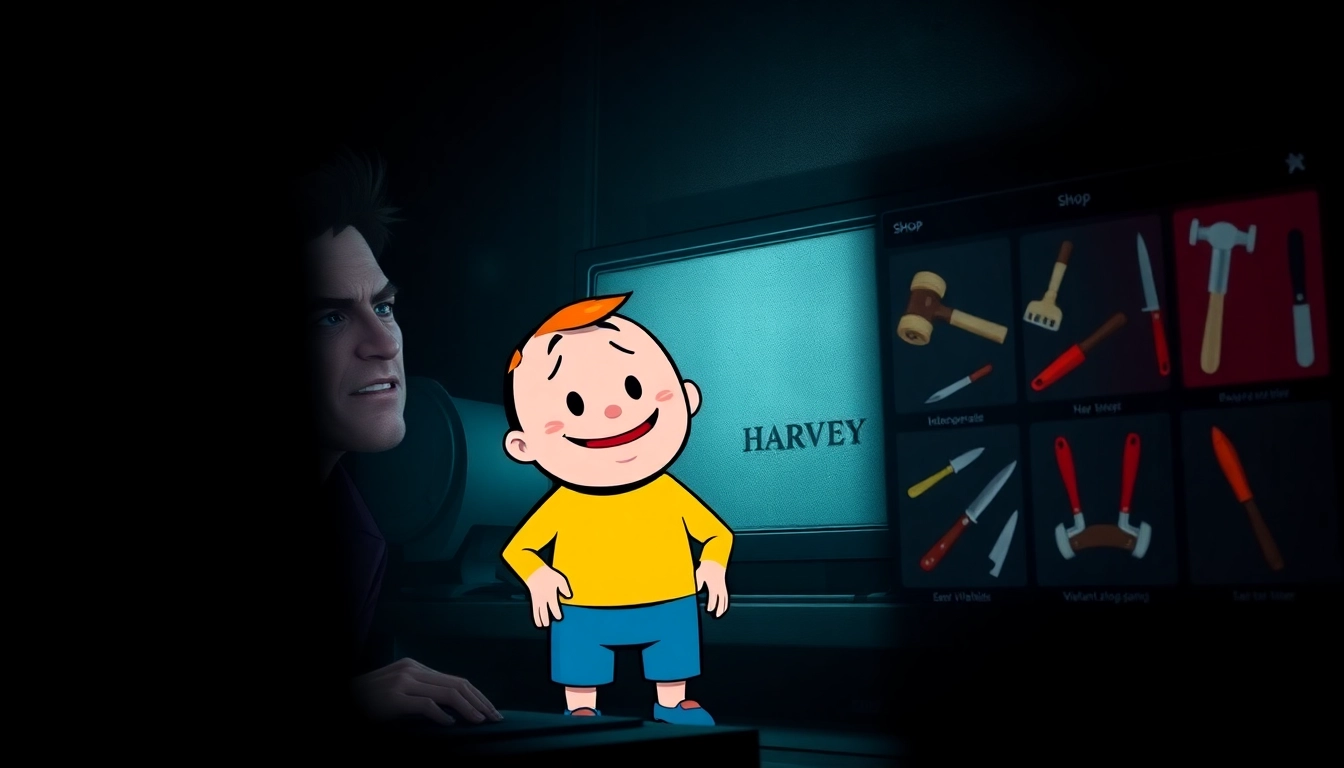Overview and Context: A Disturbing Psychological Journey in BLOODMONEY
In the realm of psychological horror and dark clicker games, few titles manage to evoke such visceral reactions and moral introspection as blood money. This game plunges players into a disturbing universe where each click not only earns vital funds but also chips away at the player’s moral integrity. At its core, BLOODMONEY is an unsettling exploration of human nature, survival instincts, and the limits of ethical boundaries, all wrapped within a simple yet profoundly impactful gameplay mechanic. The game’s premise is straightforward: you are diagnosed with a serious medical condition requiring a staggering $25,000 for treatment. With time running out and options limited, a strange figure named Harvey offers a sinister solution—click on him to generate income, but at a horrifying cost. The more you click, the more Harvey suffers, and the darker the visuals become, creating an immersive atmosphere that constantly challenges your moral sensibilities.
Bloodmoney Game Mechanics: How It Challenges Your Morality
Clicking Mechanics and Profit Generation
At the heart of BLOODMONEY lies its core mechanic: clicking on Harvey. Each click instantly produces a dollar, providing a tangible sense of progress toward the $25,000 goal. Initially, the process appears innocent—Harvey, a cheerful and seemingly kind character, invites you to click him for quick cash. However, as the game progresses, the visual and emotional toll becomes increasingly apparent. Harvey’s cheerful demeanor begins to fade, replaced by visible pain and suffering. The game cleverly uses subtle visual cues—Harvey’s changing facial expressions, trembling movements, and the gradual deterioration of his appearance—to heighten the player’s discomfort. These cues serve as a stark reminder that each profit comes at a moral and emotional cost, forcing players to confront their own boundaries.
Upgrade System and Increasing Violence
The game features a shop where players can purchase upgrades to boost earnings. These range from harmless tools like pillows to more violent instruments such as needles, scissors, and hammers. Each upgrade not only enhances the clicking efficiency but also intensifies Harvey’s suffering and visual deterioration. The game’s design intentionally pushes players toward increasingly disturbing choices—do they opt for rapid profit with maximum harm or choose a more humane, slower approach? The upgrades challenge players to weigh the immediate benefits against the long-term moral consequences, creating a risk-reward dynamic that is both psychologically taxing and morally ambiguous.
The Dark Narrative of BloodMoney: A Moral Labyrinth
Multiple Pathways and Endings
One of BLOODMONEY’s most compelling features is its branching narrative—your choices directly influence the outcome. There are three primary endings: the Good Ending, the Normal Ending, and the Bad Ending. Achieving each depends heavily on how you balance profit with Harvey’s suffering. The Good Ending typically involves minimal harm, careful selection of upgrades, and preserving Harvey’s dignity. The Normal Ending involves moderate violence and some moral compromise, while the Bad Ending is characterized by maximizing profit at the expense of Harvey’s well-being, often resulting in the most disturbing visual and emotional consequences.
This branching structure underscores the game’s central theme: moral choice is complex and multifaceted. Every click, every upgrade, and every decision contributes to Harvey’s fate, reflecting the player’s moral compass. The game subtly tracks these choices, revealing a nuanced picture of morality under duress. The different endings serve as a mirror to players’ values—are they compassionate, pragmatic, or ruthless? The game’s design encourages reflection on the real-world implications of such choices, making BLOODMONEY much more than a mere clicker game.
The Psychological Horror: Creating Unsettling Atmospheres
Visual and Emotional Impact
BLOODMONEY masterfully crafts an atmosphere of escalating horror through its visual design and emotional cues. Initially, Harvey appears as a cheerful, almost cartoonish figure, which creates a stark contrast with the gruesome acts he endures as the game advances. As the player continues clicking and purchasing upgrades, Harvey’s appearance becomes increasingly grotesque—his face contorted in pain, his body marked with wounds, and his eyes reflecting fear and despair. These visual changes are subtle yet powerful, fostering an emotional connection that makes each act of harm feel more visceral and disturbing.
The game’s sound design complements its visuals—harsh, discordant noises, and unsettling silence heighten the sense of dread. Dialogue and subtle dialogue cues reveal Harvey’s confusion and surprise at the violent tools, implying that he may not fully understand what he’s being subjected to. This adds a layer of moral complexity: is Harvey complicit, or is he oblivious? The emotional weight of these details forces players to grapple with uncomfortable questions about consent, suffering, and morality.
The Shop System and Its Psychological Effects
From Innocence to Violence
The shop is a central hub for upgrades, each representing a moral choice. Early on, tools like pillows or light needles seem innocuous, but as the game progresses, the options become increasingly violent—scalpels, hammers, and even weapons that suggest torture. Each purchase boosts earnings but also deepens Harvey’s suffering and visual deterioration. This progression mirrors the player’s descent into moral compromise, blurring the line between survival and cruelty.
Interestingly, players have observed that Harvey often reacts with surprise or confusion when presented with violent tools, suggesting he might not fully comprehend the damage inflicted. For example, Harvey might be puzzled by a hammer or needle, implying he expects harmless items. This detail adds moral ambiguity—are we exploiting Harvey’s innocence, or is there a darker force controlling the shop? The game thus becomes a reflection not only of individual choices but also of the influence of unseen forces that manipulate morality and human nature.
Multiple Endings: Choices and Consequences
Deciding Harvey’s Fate
The three endings in BLOODMONEY serve as a powerful testament to the importance of moral decision-making. The Good Ending is achieved by minimizing Harvey’s suffering—avoiding violent upgrades, maintaining a compassionate approach, and perhaps even refusing some upgrades altogether. This ending underscores themes of empathy and humanity, showing that even in desperate circumstances, kindness can prevail.
The Normal Ending involves a balanced approach—some harm is inflicted, but not to the maximum extent. It reflects a pragmatic attitude, where survival is prioritized but with some moral restraint. The Bad Ending is the most disturbing—players maximize profit regardless of Harvey’s suffering, often using the most violent tools available. Harvey’s appearance is almost unrecognizable, and the visual and emotional toll culminates in a grim conclusion. This pathway forces players to confront the darker aspects of human nature—greed, ruthlessness, and moral indifference.
The game’s nuanced tracking of choices ensures that each playthrough provides unique insights into morality. It challenges players to consider not just what they would do in a game, but how they perceive morality when faced with life-and-death stakes.
The Deeper Meaning: Humanity, Morality, and Survival
Exploring Human Nature
BLOODMONEY is more than a dark clicker game—it’s a mirror reflecting the complex interplay between morality and survival. Harvey symbolizes innocence and helplessness, while the shop and upgrades represent the darker impulses within humanity. The game questions whether we are inherently good or evil when pushed to our limits. Is survival justification enough to forsake morality? Or does compassion define us, even in the most harrowing circumstances?
Players often report feeling genuine emotional distress, especially when Harvey reacts painfully to the upgrades. This emotional response highlights how deeply the game taps into human empathy and the discomfort of moral compromise. It forces players to ask themselves: how much suffering are they willing to accept or cause to save themselves? The game’s layered narrative and visual storytelling elevate it beyond a simple clicker—making it a profound meditation on morality and human nature.
Community Insights and Player Reactions
Player Experiences and Interpretations
The BLOODMONEY community is vibrant and reflective, with players sharing insights into their gameplay and moral choices. Many discuss how the game’s design effectively evokes empathy, guilt, and moral dilemma. Some players focus on achieving the Good Ending, emphasizing restraint and compassion, while others admit to succumbing to greed, choosing the most violent options for maximum profit.
Observations about Harvey’s reactions are widespread; players notice his surprise at violent tools, which suggests he might be unaware of the true nature of what they are inflicting. This detail sparks debates about innocence, exploitation, and the invisible forces that may be manipulating the scenario. The community often discusses how BLOODMONEY challenges their perceptions of morality and tests their boundaries—prompting philosophical questions about human nature that extend well beyond the game.
Video content on platforms like YouTube, including full story explanations and gameplay analysis, further underscores the game’s impact on players. Creators highlight its emotional depth, storytelling, and moral complexity, reinforcing BLOODMONEY’s status as a thought-provoking horror experience.
Reflection: Ethical Questions and the Power of Psychological Horror
Raising Awareness Through Dark Gameplay
BLOODMONEY exemplifies how psychological horror can serve as a mirror to society’s darkest tendencies. By forcing players to confront uncomfortable choices, the game promotes introspection about real-world morality, empathy, and the lengths individuals will go to survive. It underscores that even in virtual environments, moral boundaries are porous, and the consequences of our decisions can be profound.
The game’s design—employing subtle visual cues, dialogue, and branching narratives—creates an immersive experience that leaves lasting emotional impressions. It challenges players to consider their own moral limits, making BLOODMONEY a powerful tool for ethical reflection and discussion.
Conclusion: The Enduring Impact of BLOODMONEY
In the end, BLOODMONEY is a stark reminder of the complex relationship between morality and survival. Its innovative use of clicker mechanics, combined with a dark narrative and emotional storytelling, makes it a standout title in psychological horror. The game masterfully tests players’ moral boundaries, asking: how far are you willing to go for your own survival when faced with innocent suffering?
As players navigate Harvey’s dark journey, they are invited to reflect on their own values and the nature of human morality. Whether choosing the compassionate path or the ruthless pursuit of profit, each decision leaves an indelible mark on Harvey’s fate—and on the player’s conscience. BLOODMONEY’s effectiveness lies in its ability to blend simple gameplay with profound ethical questions, making it a haunting experience that lingers long after the screen goes dark.
For those intrigued by moral dilemmas and psychological horror, BLOODMONEY offers a disturbing yet enlightening exploration of human nature. Its narrative complexity and emotional depth make it a must-try for fans of dark storytelling and provocative gameplay. To delve deeper into this unsettling universe, explore more about blood money and the moral challenges it presents. Remember, every click counts—how you choose to click could define your own moral landscape.
Are you prepared to face the moral consequences? Engage with the dark side of human nature and discover just how far you’re willing to go in BLOODMONEY: where every choice reveals the true cost of survival and the depths of moral decay.






